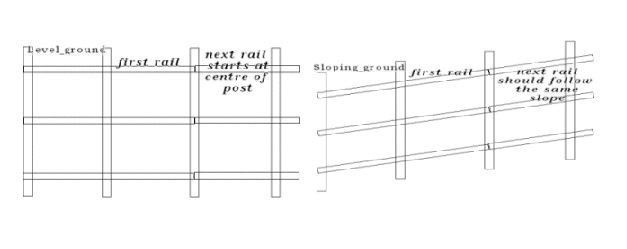Build an Upright Palisade Fence
An upright palisade fence, is one of the sturdiest fences you can build.
Unlike panel fencing, it is much more resistant to wind because the gaps in between allow wind to pass through it, making it almost impossible for heavy storms to knock your fence over. Panel fences have the opposite effect, acting like a huge sail and taking the full force of the wind. If you are building a new fence or replacing one which has been storm damaged, you should consider building an upright palisade.
Our step by step guide below shows you how to build a 6ft (1.8m) fence. If you want a different height, you will need to alter the materials accordingly.

- Materials
- 2.4m (8ft)treated timber fence posts (4 x 4)
- 75mm x 38mm 3.6m lengths of treated off-sawn timber (for the horizontal rails)
- 100mm x 22mm lengths of treated off-sawn timber (cut to 1.8m lengths, for the vertical straps)
- 75mm galvanised nails
- 40mm galvanised nails
- post mix (1.5 bags for every fence post)
- Tools
- spade (preferring a hole digging or trench digging spade)
- string line
- spirit level
- hammer
- saw
You will be using 2.4m, 4 x 4 (100mmx100mm) posts. You should place a post every 1.8m so measure the distance you want to cover and divide by 1.8m, then add one extra. For the horizontal rails, you will be using three rails to span across two posts. So, divide the full length by 3.6 and multiply by 3. Vertical straps usually come already cut to 1.8m lengths. If not, ask your timber merchant to cut them to size for you. You will need roughly 10 of these per metre. Make sure all your timber is treated. Timber merchants will often describe this as 'green treated'.
Using a string line as a guide, dig the fence post holes 1.8 metres apart. You must make sure that every second post is 3.6m or under from centre to centre to ensure your horizontal rails will span two posts.
For 2.4m (8ft) fence posts, you are looking to get around 60cm (2ft) of the post into the ground so you should aim for this depth of hole. Don't worry if you're not too exact, you will be cutting the tops of the fence posts when you finish the fence. Dig your holes as narrow as you can but wide enough so that your post will sit in it with space all around for the post mix. If the ground you are digging is very soft, you should at least try to dig down to solid ground and, if this makes the hole too deep, you can fill it up to the required height with post mix.You will need an assistant for this part.
Start with the posts at each end of the run. We will be using ready mixed post mix because this is more convenient but, if you have a cement mixer, you can mix up your own concrete. Add a little of the post mix to the bottom of the hole before you place your post in it. Set each post into the ground, making sure the post is oriented to the fence line. You are going level each post on both planes - on the front face of the post and on the side face.

Keep on checking the level of the posts while you get your assistant to add the post mix to the hole. Follow the manufacturers instructions with regards to adding water to the mix. Finally, firmly tamp down the mix and re-level the posts. It is important the you are as accurate as you can be with your post levels since a squint post will show up on the finished fence.
Once you have your two end posts level and set, carefully tie your string line between them about half way up the posts. Make sure your line is nice and taut since you will use it to keep the rest of your posts running in a straight line.
Set in the rest of your posts, levelling them as before only this time you will need to make sure that the front face of each post is just touching the string line.
When you have finished, go back over each post and check the levels again before the leaving the post mix for one to two days to fully harden.
You are going to use 3 rails to support the vertical straps and you will nail them onto the fence posts with even spaces between them. Start at the bottom and nail the first rail onto the posts at around 20 cm from the foot of where you want your fence to be. If you are working on level ground, you can use your level to level the rails but, if you are going to follow a slope with your fence, you should run your rails to match.

Put the top rail around 20cm from the top of your fence and then measure out the third so that it sits directly in the middle of the two. Continue in this way until you have railed up the full fence.
You are going to start by nailing one strap at each end of the fence. It is essential that you make sure your first strap is plumb so that the fence will look nice and straight. Use your level to do this by placing it on the side of the strap. The straps should be double nailed at each rail. When you have done this, run a string line across the top of each strap and pull it taut. the string line will help keep your fence running straight at the top.
Choose the size of gap you want between each strap and find a long spacer of the correct size. For a nice small gap of 22mm, you can use the side of a spare fencing strap. This will give you good, even spacing between each strap. Using the string line to guide you, nail up all the straps. Because of the nature of off-sawn timber, your straps will not always be uniform all the way down so you should check that the straps are still running plumb every ten or so and make any necessary adjustments.
When you have completed your fence, you will probably find that the posts are not all level at the top. Simply saw off the top of the posts using a slightly sloping cut so that the rain water will run off the top of the post and seal the cut with wood seal to protect the wood.
If you intend to stain your fence, you should do so as soon as possible while the wood is still clean. Treated wood doesn't have to be stained and will eventually fade to a silvery grey but, if you want a coloured fence then choose a stain that will still let the grain of the wood show through.
Want more from Gardenzine? Search Gardenzine for articles here:











